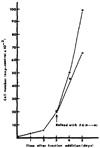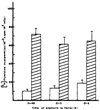Isolation of an autocrine growth factor from hepatoma HTC-SR cells
- PMID: 3584247
- PMCID: PMC3005268
- DOI: 10.1002/jcp.1041310205
Isolation of an autocrine growth factor from hepatoma HTC-SR cells
Abstract
A growth factor has been isolated from HTC-SR rat hepatoma tissue culture cells which specifically stimulates DNA synthesis and cell proliferation of the HTC cells that produce it. The factor can be isolated from HTC cell conditioned medium or from an HTC cell extract. This autocrine factor has been purified 640-fold from a postmicrosomal supernatant by successive steps, involving ethanol precipitation, heating at 80 degrees C for 10 min, chromatography on a DEAE Bio-Gel A column, and chromatography on a heparin-sepharose affinity column. The major peak of activity eluted from the heparin column migrates as a single band on SDS-PAGE with an apparent Mr of 60,000. The factor is resistant to acid, heat, and neuraminidase but sensitive to trypsin, papain, and protease. The autocrine nature of the factor is indicated by the finding that several other types of cells do not respond with increased DNA synthesis. Mouse L-cells, BHK cells, Novikoff hepatoma cells, hepatocytes in primary culture, and an epithelial-like rat liver-derived cell line (Clone 9) were tested, and none of the cells could be stimulated. Small amounts of the factor could be extracted from the Clone 9 cells, however. This material had the same physical and purification properties as the factor extracted from HTC cells, but it did not stimulate DNA synthesis in Clone 9 cells, only in HTC cells. Addition of the factor resulted in an almost immediate stimulation of DNA synthesis in a proliferating HTC cell population. When the factor was added together with [3H]thymidine for 2 h, a significant stimulation of DNA synthesis was observed, provided the addition was made between 18 and 48 h after the cells had been plated. Autoradiographic studies indicated that the factor both accelerates DNA synthesis in cells already making DNA and increases the number of cells entering the S period. The stimulation of DNA synthesis was completely inhibited by 10 mM hydroxyurea, whether the factor was present for 2, 24, or 48 h in the culture. A significant increase in cell number due to addition of the factor was also observed. This accelerated proliferation was detectable only after the cells had been in culture for at least 48 h with the factor present.
Figures








References
Publication types
MeSH terms
Substances
Grants and funding
LinkOut - more resources
Full Text Sources
Other Literature Sources
Research Materials

